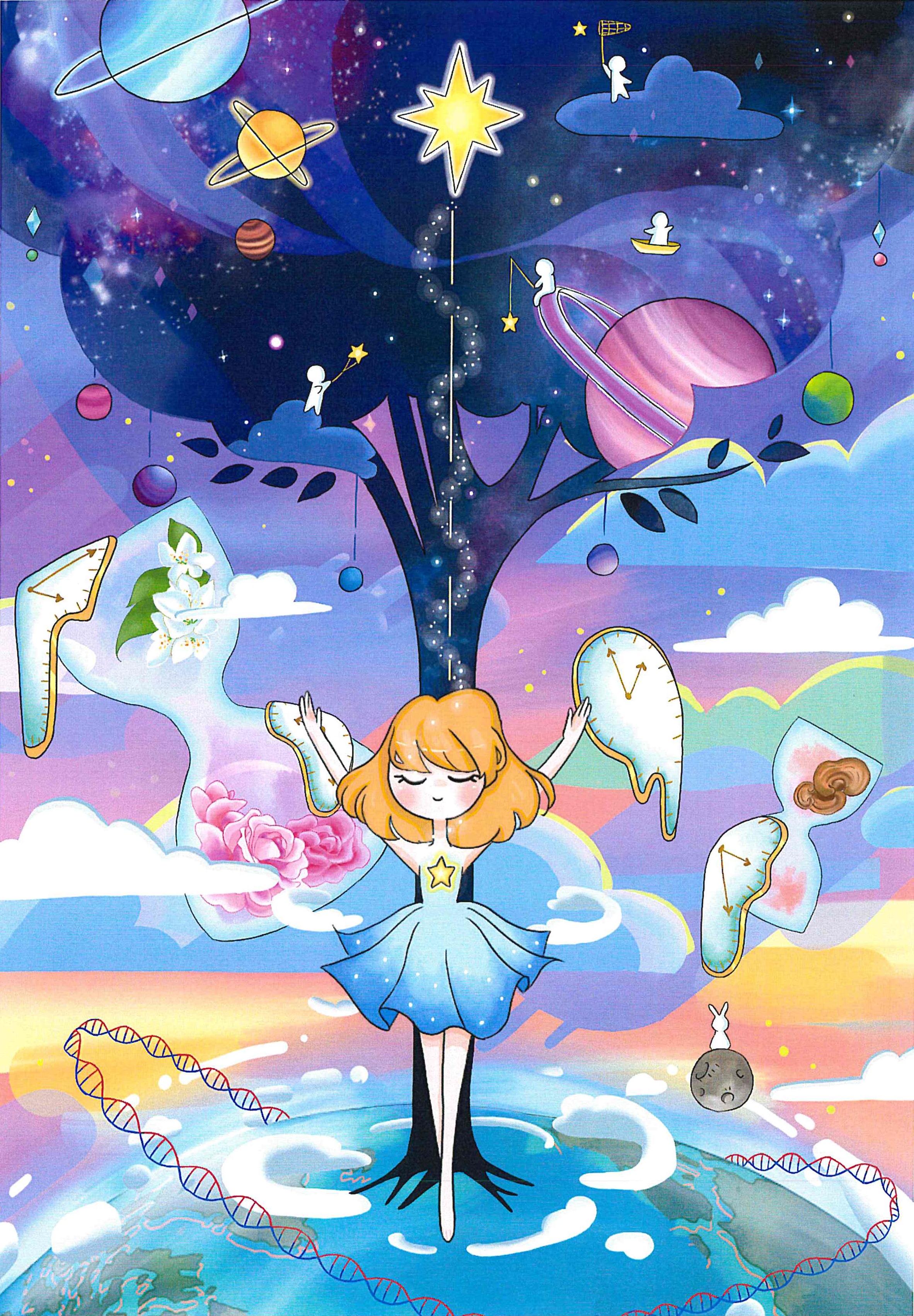
A visual representation of "Vanilla in the stars" by Agnes Lam
YU Joy See Phoebe
St. Paul's Convent School
My artwork tries to capture the idea that people who are fragments of the same stars in the cosmic world are destined to unite in the human world. This picture also summarises our life cycle, the fantasy of searching for our close ones, the mysteries and infinite possibilities of the universe. I have used both dark and vivid colours to present the mystique of the universe. Vibrant and lighter colours are used to draw the sky, signifying that ‘life’ coming from the stars is fascinating.
The idea that we are made of cosmic dust is shown by the biggest star connecting to the young girl below it. The girl would pass on the ‘stardust’, which is stored in the star on her chest, to her descendants. Moreover, the DNA strip circling the earth symbolises the star fragments passed down as DNA in different generations.
Furthermore, by drawing the giant celestial tree and plants in the garden where the writer always played in her childhood, the idea of cosmic dust nourishing life is shown. The dripping clocks signify that time goes on for eternity and our search for our soulmates will never end. The same idea is also reflected through the people in the galaxy, waiting to sense a whiff of something familiar. Lastly, the hourglass symbolises reincarnation, which means our life cycle is endless and we will be reborn once the hourglass turns upside down.
Vanilla in the stars
When I was a child,
I used to gaze at the stars above
our garden of roses, jasmine and lingzhi by the sea,
wondering how far away they really were,
whether they were shining still at the source
by the time their light reached me …
I was told that everyone was born with a star
which glowed or dimmed with the fortunes of each.
I also heard people destined to be close
were at first fragments of the same star
and from birth went searching for each other.
Such parting, seeking, reuniting might take
three lifetimes with centuries in between.
I had thought all these were but myths …
Now decades later, I read about the life of stars,
how their cores burn for ten billion years,
how towards the end, just before oblivion,
they atomize into nebulae of fragile brilliance –
ultra violet, infra red, luminous white, neon green or blue,
astronomical butterflies of gaseous light
afloat in a last waltz choreographed by relativity,
scattering their heated ashes into the void of the universe …
Some of this cosmic dust falls onto our little earth
carrying hydrocarbon compounds, organic matter
able to mutate into plant and animal life,
a spectrum of elemental fragrances …
Perhaps on the dust emanating from one ancient star
were borne the first molecules of a pandan leaf,
a sprig of mint or basil, a vanilla pod, a vine tomato,
a morning frangipani, an evening rose, a lily of the night …
Perhaps our parents or grandparents or ancestors further back
strolling through a garden or a field had breathed in the scents
effusing from some of these plants born of the same star
and passed them on as DNA in the genes of which we were made …
Could that be why, on our early encounters, we already sensed
in each other a whiff of something familiar, why, when we are near,
there is in the air some spark which seems to have always been there,
prompting us to connect our pasts, share our stories even as they evolve …
… till the day when we too burn away into dust
and the aromas of our essence dissipate
into the same kaleidoscope of ether light
to be drawn into solar space by astral winds …
… perhaps to make vanilla in a star to be
before the next lifetime of three?
Agnes Lam
“Vanilla in the Stars” was published as:
Lam, Agnes. (2009). Vanilla in the stars. In P. Amato & M. J. Salfran (Eds.), Nosside 2008: XXIVth Poetry Prize anthology (pp. 89-92). Reggio Calabria: Centro Studi Bosio, Italy. (Published in English and Italian.)